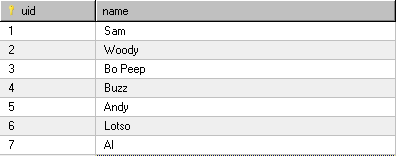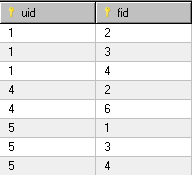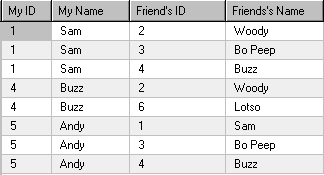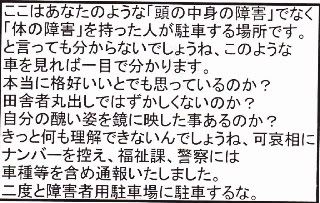Blog
-
Happy Birthday Papa
Celebrated my birthday today. My daughter chose a chocolate cake for Papa !



-
Enjoy winter in Japan
Pleasant, but chilly winter. Our garden was superb view for kids especially when it was snow !



-
Happy New Year 2011 Wishes

I wish ALL of you a very Happy & Prosperous New Year 2011 !
-
Happy New Year 2011 – Wishes to my wife
My best wishes, and sincere feelings for my wife Elena, expressed as a little poem.
-
Nicolas performing You should be dancing tonight
Hilarious, isn't it?
-
Maintaining relationship – common friends
I was posed a very trivial question from one of my friends recently. It picked my interest, since I could not readily solve it, and I had the inkling that there is a better, simple solution for this problem.
The problem was, let’s say I have a table of users as below

And these users have friends as below
 or more easier to read as
or more easier to read as 
Now, the trivial task was find common friends for users 1, and 5, hence naturally the answer should be
User 1 : Woody’s friends, and User 5 : Andy’s friends are
 and
and 
So, the question I had was what could be the best SQL query that would be return me this result?

I thought of 2 different SQL queries
SELECT f.fid, u.name 'Woody and Andy\'s common friends' FROM
(SELECT f.`fid` FROM friends f
WHERE f.`uid` IN (1,5)
GROUP BY f.`fid` HAVING COUNT(f.`fid`) > 1) f INNER JOIN user u ON (u.uid=f.fid)-or- another one was
SELECT f.fid, u.name 'Woody and Andy\'s common friends' FROM
(SELECT a.fid FROM
(SELECT * FROM friends f
WHERE f.`uid`=1) a INNER JOIN
(SELECT * FROM friends f
WHERE f.`uid`=5) b ON (a.fid=b.fid)) f INNER JOIN user u ON (u.uid=f.fid)Both seem to work, but is there any elegant way of getting common friends in a much simpler SQL query? At this moment, I logically find first SQL query more intuitive since all it does is pickup friends who appear more than once when users are 1 and 5. The second SQL query seems plain brute force approach.
-
Impolite Japanese
Got a warning ticket yesterday for parking in a “handicap” zone. (Well, it is convenient to park there, I admit). But look at the ticket content, you’ll be shocked !

Here’s how it translates (tried my best, since this is native Japanese and had to look up the dictionary many times)
This parking place is for [physically handicapped], not [mentally handicapped] person like you. Can make out from a car like yours, a person like you won’t understand. You really think your car is too cool? Aren’t you ashamed to act like a complete idiot? Did you ever see your ugly face in the mirror? Pity you do not understand, thus I noted your car number, model and informed to the nearest police station. Don’t ever park in parking reserved for handicap again !Pretty rude and forthcoming for a Japanese, don’t you think?
I wonder why didn’t this person put his number or contact in case I wish to “consult” to remedy my pitiful situation.

-
Merging pre-sorted lists
A while ago, I came across an interesting problem. We have 3 different sorted queues (entries were sorted by time), out of which we had to pickup the smallest time, and send the first arrived entry out of those 3 queues in sequence.
Q1 Q2 Q3 2 3 1 5 4 6 7 6 9 8 10 11 As you can see, all queues (Q1, Q2, Q3) are already sorted, but on application side we have to pickup entries across all queues in sorted order and process them. So the entries should be processed in 1, 2, 3, 4, 5, … 11 sequence. Frankly this is merging of already sorted lists, and a person from computer science background should already know this. But I don’t come from such background, and the solution one of my friends gave was plain amazing.
The solution was pickup first entry from each queue, compare them, choose the smallest and process it first.
Q1 Q2 Q3 Smallest 2 3 1 1 Thus, here 1 is processed first. Now pickup next entry from queue where smallest was found (Q3 in this example), so now the next comparison becomes like this
Q1 Q2 Q3 Smallest 2 3 6 2 The smallest is 2, so this is processed and next entry from Q1 was picked-up
Q1 Q2 Q3 Smallest 5 3 6 3 And so on… giving us
Q1 Q2 Q3 Smallest 2 3 1 1 2 3 6 2 5 3 6 3 5 4 6 4 5 6 6 5 7 6 6 6 7 10 6 6 7 10 9 7 8 10 9 8 10 9 9 10 11 10 11 11 A simple, and elegant solution, isn’t it? Is there any other better alternative?
